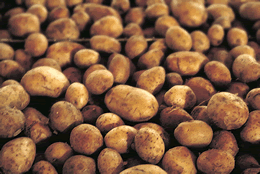Digging potatoes, a harvest worth waiting for.
“Potatoes served at breakfast, at dinner served again; potatoes served at supper, forever and Amen!”
–Pennsylvania prayer.
The gardeners and farmers who had the foresight to plant their potatoes earlier this year have an interesting few weeks ahead of them.
The harvesting of the main crop potatoes that were sown mid-late April is about to get underway. Weather permitting of course.
For many potato planters this will not be the first glimpse of their homegrown potatoes. First and second early varieties have already been harvested during July and August from seed sown that March and April. The hen’s egg sized new potatoes harvested in July are one of the highlights of the gardening year.
Gardeners wishing to steer clear of chemical spray often opt for sowing a first early or second early potato variety, as this will allow them to harvest before blight infection is at its highest (mid –summer onwards). “Colleen” and “Orla” are both early potato varieties with good blight resistance that you may like to try with this early method.
If you are looking for seed potatoes you should be able to source some here…. Seed potatoes
The time to harvest early potatoes is just after they finish flowering (before the flower becomes a green fruit), whereas your maincrop varieties are best tackled after the plants leaves turn yellow and brown. Cut away these wasted stalks (haulms) and wait for about two weeks before you attempt to harvest.
Harvesting.
The gardener’s potato harvest is very simple compared to potato harvesting by large commercial growers with their mechanised operations involving tractors, trailers, and propelled harvesters. The gardener requires just a fork, a bucket, a fine day, and a strong back.
If you are looking for a garden fork you should be able to source some here…. Garden fork
The usual plan is to start by inserting the garden fork (spading fork) into the soil a bit away from stalk bases. This distance is required to prevent the spearing of the underground treasure. You can then safely lift the roots up and forward into the light.
When harvesting your potatoes it is very important to totally clear the soil of each and every potato, even the small marbles that you may never eat. This is because left over potatoes can harbour pest and diseases within your garden e.g. wireworm, blight etc. You don’t want to be causing problem for next years crop.
Be as gentle as you can with the new arrivals doing everything possible to avoid bruising or damaging the skins. Any potatoes damaged by fork, rough handling, slug or disease attack should never be kept, as they may be the cause of you loosing a lot of your store. A fork nick or slug hole can be cut away and the potato cooked that evening to prevent it going to waste.
Now some potatoes are good keepers, others are not, and it may take you a few years of growing different varieties to discover what types store best for you. However here are a few tips to improve your potatoes storage potential…
(1) Observe the two-week wait between cutting away the wasted stalks and harvesting. This gives the potato skins enough time to set or toughen up, making them easier to store.(2) Lift the roots and let the tubers dry for several hours before moving to storage to prevent sweating.
(3) Never wash potatoes before storing as the dried soil will help preserve them.
(4) Your storage containers can be paper/Hessian sacks or slatted boxes.
(5) The storage area should be a dark, cool, frost and moisture-free location. High temperatures will encourage sprouting while wet conditions will favour the development of rotting diseases. A concrete block built domestic garage is the ideal storage candidate for the home potato grower
Right so, potatoes lifted, what’s next? Well, the ground that the potatoes vacated can be planted with wintergreens, cabbage, and cauliflower, thus taking two crops off the same piece of ground in the one year. Not bad for a seasons work. ![]()
More debate about this topic on our forum, click Irish gardeners forum.
?? Did you like this post? Yes, then click below to share it . ??








Tags: Colleen potatoes, harvest potatoes, harvesting potatoes, homegrown, how to dig potatoes, how to harvest potatoes, lifting potatoes, new potatoes, Orla potatoes, potato digging, potato harvest, potatoes, potatoes storage tips, spading fork, when to dig potatoes, when to harvest potatoes

 Advertise on Ireland's busiest website in the gardening niche....... Irish Gardeners forum.
Advertise on Ireland's busiest website in the gardening niche....... Irish Gardeners forum.





